Advertisement
Grab your lab coat. Let's get started
Welcome!
Welcome!
Create an account below to get 6 C&EN articles per month, receive newsletters and more - all free.
It seems this is your first time logging in online. Please enter the following information to continue.
As an ACS member you automatically get access to this site. All we need is few more details to create your reading experience.
Not you? Sign in with a different account.
Not you? Sign in with a different account.
ERROR 1
ERROR 1
ERROR 2
ERROR 2
ERROR 2
ERROR 2
ERROR 2
Password and Confirm password must match.
If you have an ACS member number, please enter it here so we can link this account to your membership. (optional)
ERROR 2
ACS values your privacy. By submitting your information, you are gaining access to C&EN and subscribing to our weekly newsletter. We use the information you provide to make your reading experience better, and we will never sell your data to third party members.
Careers
Podcast: Scientist couples share their stories and struggles
To celebrate Valentine’s Day, Stereo Chemistry is highlighting adorkable romances and advice for making a STEM relationship work
by Linda Wang and Matt Davenport
February 13, 2019
Jump to:
Photo slideshow: We heard so many heartwarming chemistry love stories
They say love is a many-splendored thing, and we have to agree. In the latest episode of Stereo Chemistry, love lets us use a single podcast to discuss a rotovap romance, intimate feelings formatted for the Journal of the American Chemical Society, and the slow but tireless march of equality. C&EN spoke with five chemistry couples about their love stories, as well as what advice they have for those trying to give love a chance in a science, technology, engineering, and mathematics (STEM) profession. You’ll hear real talk about fears and doubts, about struggling with work-life balance, and about solving the two-body problem. And you’ll also hear some of the cutest gosh-darn stories we’ve ever had the privilege of sharing.
Subscribe to Stereo Chemistry now on iTunes, Google Play, or TuneIn.
Update: Feb. 13, 2020
We checked in with some of the scientist couples in our podcast to see how they are doing nearly a year after it released. Here’s what they said.
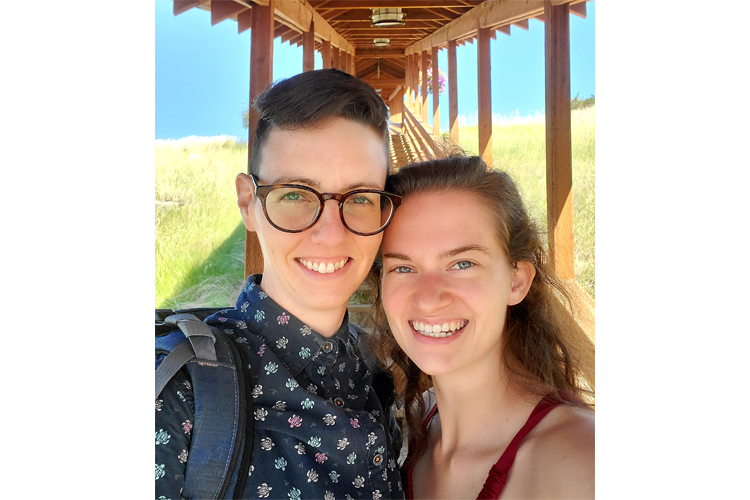
Lee (left) and Riki
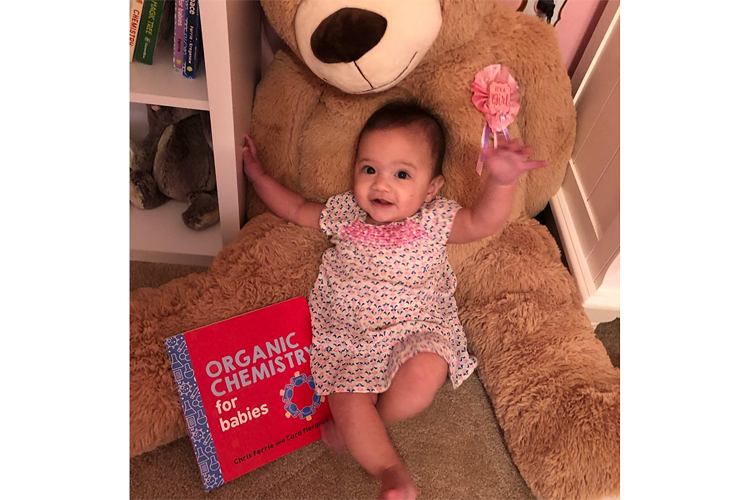
Danielle and Arjel
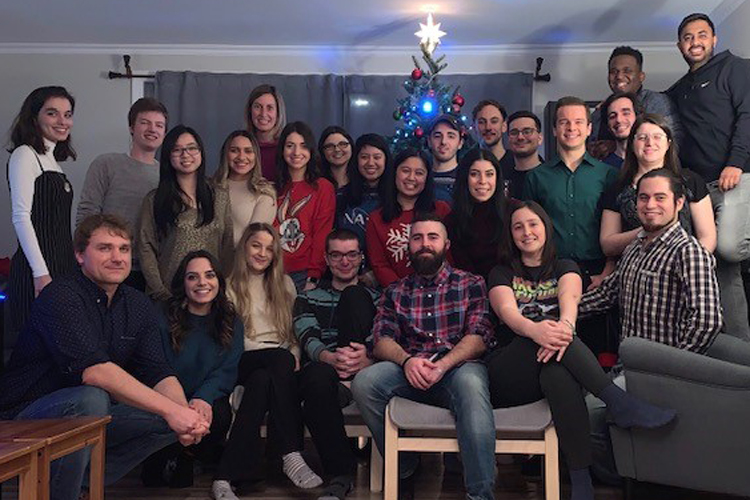
Ashlee (back row, fifth from left) and Marek (front row, far left)
The following is the script for the podcast. We have edited the interviews within for length and clarity.

Linda Wang: I’m Linda Wang.
Kerri Jansen: And this is Kerri Jansen. You’re listening to Stereo Chemistry.
Linda: It’s the middle of February, so it’s probably no surprise to anyone that this a Valentine’s Day episode.
Kerri: I mean, you can’t have love without chemistry. And we mean that in the metaphorical sense, but also in the literal sense. This is a chemistry podcast, after all.
Barbara Belmont: You know, it’s just biochemistry, right?
Shelley Diamond: It’s the chemistry of the brain.
Barbara Belmont: It’s the chemistry of the brain and it’s the same for everybody. We all go through the same process. It’s all about the endorphins, man.
Kerri: That was Barbara Belmont and Rochelle, or Shelley, Diamond. And during this episode you’ll be hearing more from them, as well as a few other chemistry couples. Those are couples in which each half is a chemist, or at least a scientist with ties to chemistry.
Linda: For instance, Barbara is a lecturer in the Chemistry and Biochemistry Department at California State University, Dominguez Hills. And her wife, Shelley, is the manager of the Flow Cytometry/Cell Sorting Facility at the California Institute of Technology.
Kerri: Barbara and Shelley are just one of the many chemistry couples we heard from while working on this podcast. I don’t think we were expecting to get so many responses to our call on social media asking for your stories.
Linda: Yeah, we got dozens of responses in just a couple of days. And although every story was unique, we definitely noticed some trends.
Kerri: For instance, it’s no surprise to hear that chemists met and fell in love in school, across the lab bench, or at conferences. The couples also face a lot of similar challenges.
Linda: Like trying to figure out how to leave chemistry problems at work. Or navigating the two-body problem, which is figuring out how to find two jobs that won’t geographically separate you as a couple.
Kerri: In this episode, Stereo Chemistry will be playing third wheel to five different chemistry couples to talk about their love, their struggles, and of course, the nerdy ways they met.
Linda: In the first half of the episode, we’re going to share those stories of how they fell in love. Spoiler alert: some analytical instruments are involved.
Kerri: In the second half, we’ll dive deeper into how the couples deal with hardships. In reflecting on those challenges, our chemistry couples are also going to share advice with all the lovebirds listening out there. So you’re going to want to stick around.
Linda: Before we jump in, we want to first thank everyone out there who shared their stories with us. We literally couldn’t have done this without you.
Kerri: We couldn’t fit all of the amazing stories into this episode, but we’ll share more of them on our website at bit.ly/chemcouples.
We heard so many heartwarming chemistry love stories for this podcast that we couldn’t possibly fit them all into one episode. But don’t worry, we’ve got a few more for you in this photo slideshow. We’ve edited the stories for length and clarity.
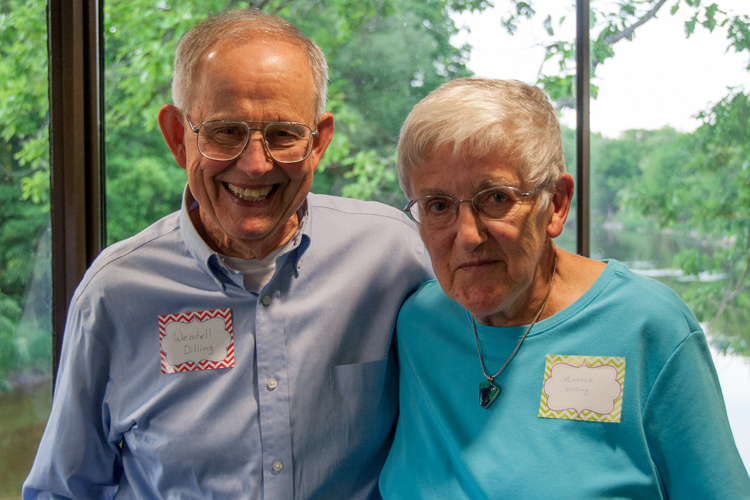
Wendell Dilling and Marcia Taylor

Tessy and James Ritchie
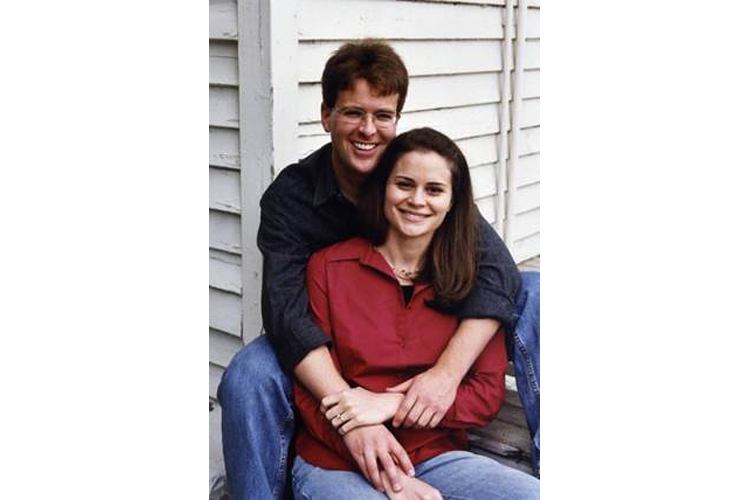
Shawn Burdette and Emma Palmacci
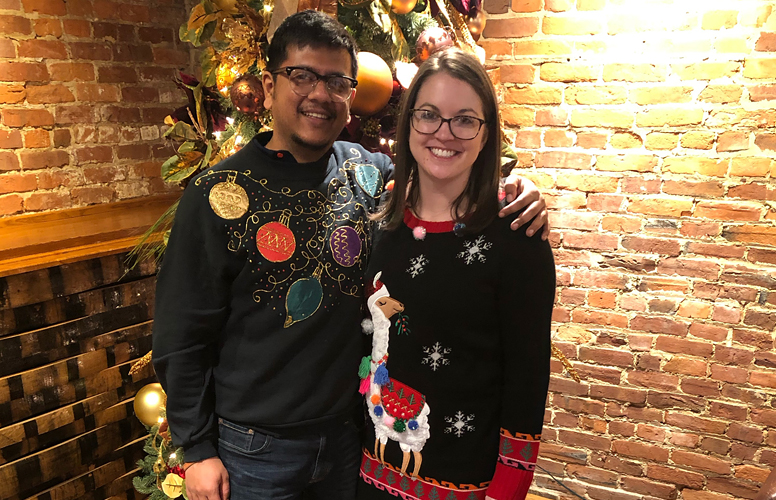
Purujit Gurjar and Jessie Ringo
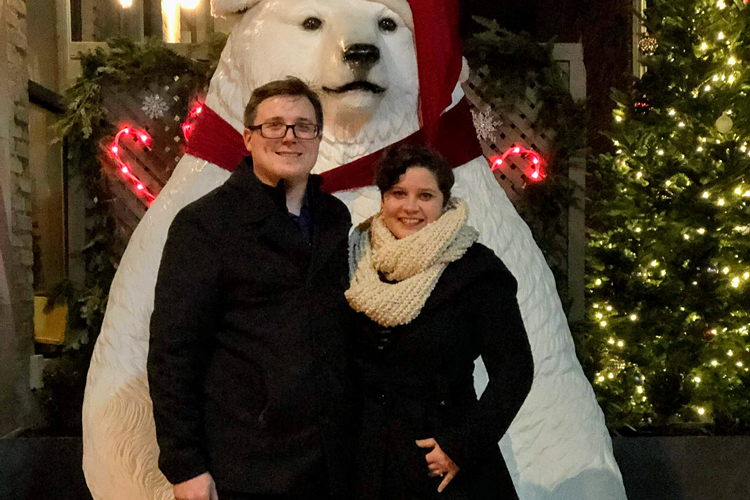
Samuel Esarey and Isabel Colon-Bernal

Christine Geosling and Louis Newman
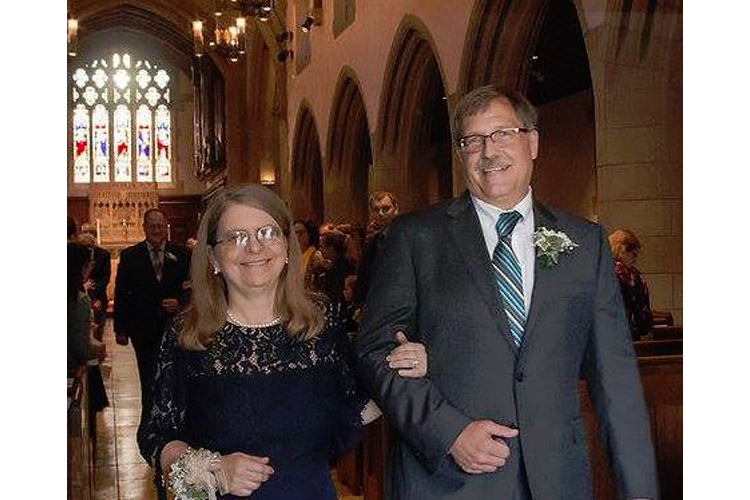
Nancy and Jim Scripko

George and Kelly Amoto
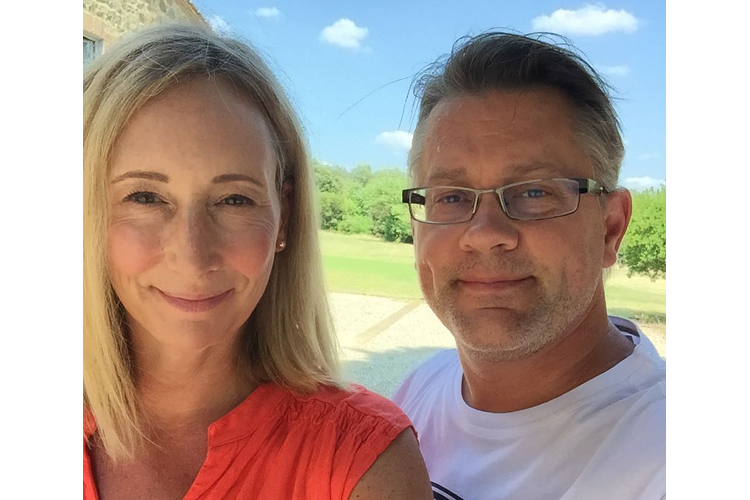
Jennifer Finnegan McCafferty and Dewey McCafferty
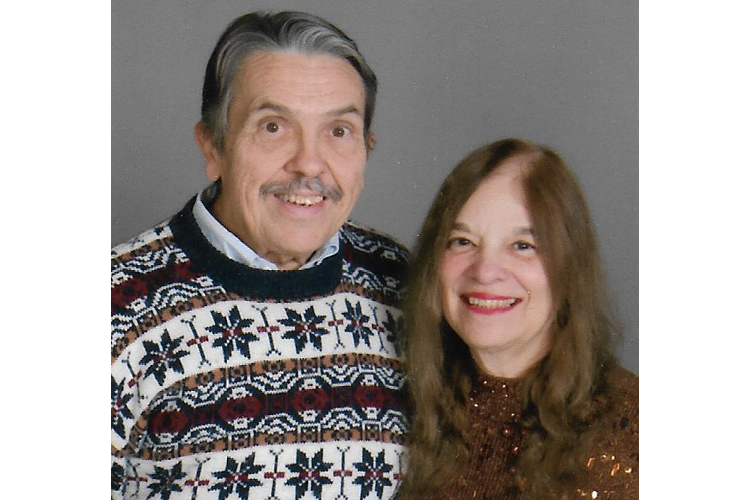
James and Dana Barry
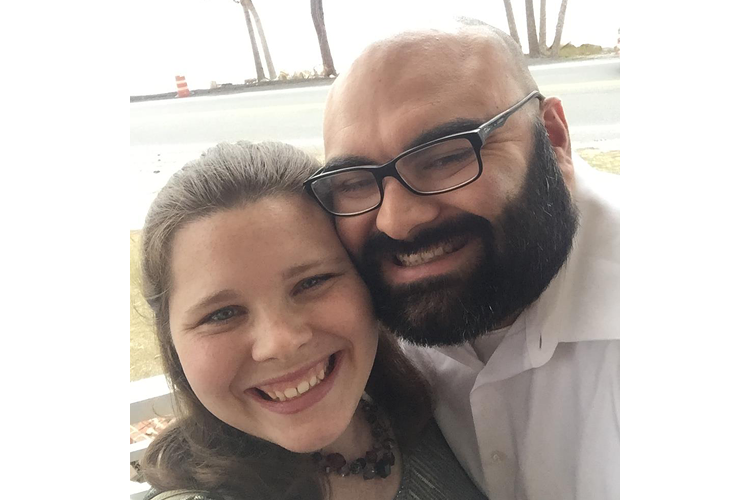
Becca Hill and Ted Helgert

Simon Fairbanks and Felicity Noakes
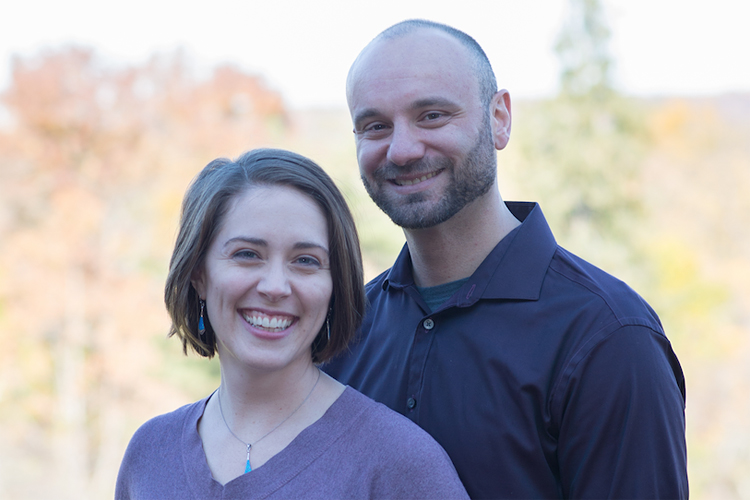
Anne Hylden and Bob Rarig
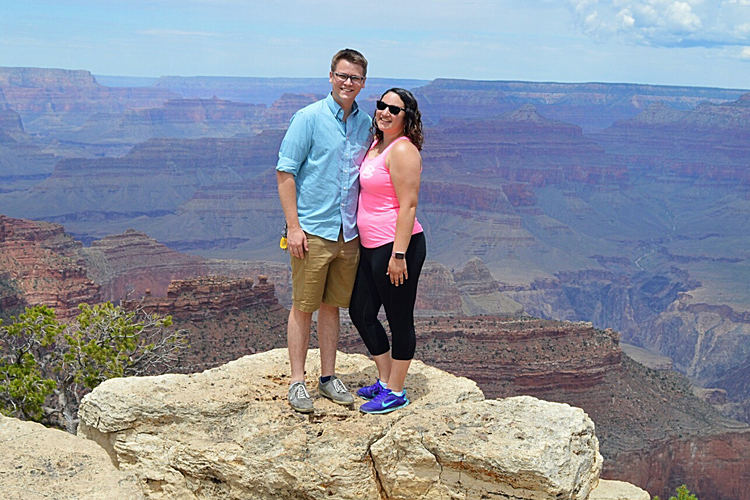
Tyler Kerr and Angelika Trujillo
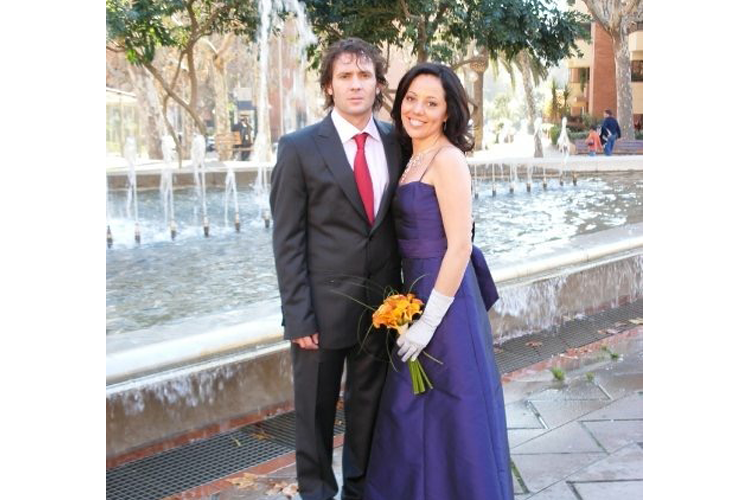
Guillem Aromi and Leoni Barrios

Jeremy Eberle and Madeline Smith
Linda: All right, so I think that takes care of all the bookkeeping. Let’s hear from the couples.
Kerri: You already met Barbara and Shelley briefly. They met in 1982, giving them the title of longest relationship in this episode. As their prize we’ve decided to give them the last word.
Linda: So now we’re going to introduce you to Kinjal Majumder and Erica Wunderlich Majumder, who are both postdocs.
Kerri: Kinjal’s working in immunology at the University of Missouri. Erica was also at Mizzou, but her PI retired this summer. Rather than finding a new group and sort of starting over, she decided to continue working on her project with a group of collaborators at Scripps Research Institute in California. More about how they’re making the long-distance relationship work later. They met doing undergraduate research at Drury University, a small liberal arts college in Missouri.
Erica Wunderlich Majumder: In some ways, our relationship is so serendipitous because Kinjal was an international student from India when we met in undergrad. And you know, like, how in the world he ended up at this tiny college in the middle of nowhere, Missouri.
Linda: Serendipitous though it may have been, it wasn’t love at first sight.
Kerri: Erica and Kinjal spent a ton of time together, in class, doing undergrad research, even working together in the student chapter of the American Chemical Society. The ACS publishes C&EN.
Linda: Kinjal tells us that, through all of this, they weren’t even dating. So we wanted to know, What changed? How did they go from friends to, well, more than friends?
Kinjal Majumder: It was just a natural progression, you know. And there was nothing, there was no big event or anything like that.
Kerri: They still had just about the best first date a chemist could ask for.
Erica Wunderlich Majumder: It was actually very cute. Our first date was to this play called Copenhagen, which is just a three-person play, but it’s about Niels and Margrethe Bohr and their conversations with Werner Heisenberg at the outbreak of World War II. Not exactly a romantic play, but it was . . .
Kinjal Majumder: Very thought provoking. We were both on the edge of our seats the entire time, as I recall.
Erica Wunderlich Majumder: I think we’re the only ones in the audience that were.
Kinjal Majumder: I do remember seeing a gentleman falling asleep during the play right across from me. You know, I couldn’t believe someone was falling asleep during such a fascinating play.
Linda: They started dating their senior year of undergrad and traveled to Saint Louis together to go to grad school at Washington University in Saint Louis.
Kerri: And they got married their first year there.
Linda: They’ve been together through the stresses of graduate life. Then finding postdocs that kept them together in the same place, at least until Erica’s recent and temporary move to Scripps.
Kerri: And through all of that, they kept the chemistry alive. At least according to the undergrads they work with.
Erica Wunderlich Majumder: Kinjal would come over to my lab to help me with something and one of my undergrads was like, “Who are you flirting with?” And I was like, “That’s my husband.”
We were just talking about PCR, so I don’t know what was flirty about that.
Linda: We’ll hear more about how they’re making the chemistry last a little later in the episode. But, you know, we heard from a lot of couples and we wanted to share at least one story with a grand, nerdy, romantic gesture.
Kerri: This story comes from Danielle Guarracino, an associate professor of chemistry at the College of New Jersey, and her husband, Arjel Bautista, who works in predictive analytics for Bristol-Myers Squibb.
Linda: The two met in grad school around 2008, working in Alanna Schepartz’s chemical biology group at Yale.
Danielle Guarracino: We sat incredibly close to each other. Like just a desk away, a bench away, and so, they say familiarity breeds contempt, but not in our case. I’d say that working in the same lab and kind of the antics that we got up to in lab wound up cementing what we became as a couple.
Arjel Bautista: We were in a chemical biology group, so oftentimes we had to spend late nights in the HPLC room, and that bred a lot of conversation, and that’s how we became fast friends.
Kerri: Want to hear about some of those antics? Prepare yourself because this is adorable. They would send each other notes during group meetings written in amino acid codes.
Linda: Scientists have given a single letter code to each of the naturally occurring amino acids that make up proteins.
Kerri: So imagine Danielle wanted to write a note that said “Hi” to Arjel. She’d draw the structure for histidine, H, and isoleucine, I.
Arjel Bautista: Yeah, so basically, if we, like, ever got caught, then it’s like, oh, you know, we’re discussing science.
Linda: Despite their attraction and their adorable antics, Danielle tells us their relationship in grad school was an on-again, off-again affair.
Advertisement
Kerri: Working in the same lab kept them close, but it also created a sense of competition between them. Based on what we know of romantic comedies, we have to believe there was some truly captivating will-they, won’t-they tension in the lab, right up until Danielle was graduating.
Linda: Danielle was two years ahead of Arjel, so she was finishing up, preparing to defend and move on to a postdoc at New York University. So they had a decision to make.
Kerri: Cue the grand gesture.
Arjel Bautista: You know I was thinking to myself, and I was like, “I cannot let her leave without me telling her how I feel about her.” So what I actually did was I took the JACS, so the Journal of the American Chemical Society, their template, and I wrote her a communication.
Danielle Guarracino: Yes.
Arjel Bautista: Like basically a letter in a communication format.
Danielle Guarracino: Yep.
Arjel Bautista: And put figures in with pictures of things we’d done while we were together at Yale.
Kerri: But wait. There’s more.
Danielle Guarracino: He came to my apartment and he actually sang to me and he brought a rose. It was really very TV, it was very romantic comedy. But it was so sweet and he basically was saying, like, don’t forget me.
Linda: So they started dating, doing a little bit of the long-distance thing between Yale and NYU, until Arjel also graduated and got a postdoc at NYU. Then in 2011, they decided to take the next step.
Danielle Guarracino: And so I put together this letter where I kind of wrote my feelings to him now, kind of similar to how he had he had done for me with the JACS communication, although mine was just a regular letter. But then at the end of it, you kind of flip over and it went into ChemDraw and it basically had “Will you marry me?” written out in the amino acid code. And he read the letter and he got to the last page, and he was like, “Wow.”
Arjel Bautista: It was really romantic, and when I got to the last page of that letter, I had no choice. I was just like, “Yes.” There’s no other answer in my heart.
Linda: Arjel and Danielle are expecting their first child in March. It’s a girl.
Kerri: So Linda.
Linda: Yes, Kerri?
Kerri: Are you ready to take this podcast north of the border?
Linda: Heck yes.
Kerri: Well, bundle up, because we’re heading to Canada to meet Ashlee Howarth and Marek Majewski. Both are assistant professors in the Department of Chemistry and Biochemistry at Concordia University in Montreal.
Linda: They actually met on the other side of Canada, when Ashlee was visiting the University of British Columbia as a prospective grad student. Marek was a grad student at the time working in Michael Wolf’s lab. And Ashlee would remember Marek because instead of showing her slides and talking about the Wolf group’s research, he asked her an unusual question.
Ashlee Howarth: “Why don’t we go throw a football around in the courtyard?” And I thought that was really cool, personally. I thought it was a very different approach. It was a nice break in my day, in my very serious grad school interview day. And so we went out and we played some football and I immediately had a little crush, and I think he did, too.
Marek Majewski: Can confirm, can confirm. So she has a real cannon of an arm. And so I, along with a few of my other friends from graduate school, we were all immediately impressed. She was very impressive in that respect. And then, of course, she’s gone on to be a very impressive scientist.
Linda: Ashlee decided to join the Wolf group with Marek. And after a little while, it was clear that they had a connection that went beyond the initial crush.
Marek Majewski: Very early on she went to use the rotovap in our lab, but she had never used the rotovap before. And she came and she asked me, she said, “Could you show me how to use the rotovap?” And I think she could tell immediately that I was going to give her a bit of a hard time. And before I could say anything, she immediately said, “Be nice.” And as soon as she said, ”Be nice,” I said, you know, “She read me perfectly here.”
Ashlee Howarth: I asked him if he could help me, and I immediately saw the stern look on his face. And as soon as I said, “Be nice,” I saw him melt. And I was like, “Aha! I know how to get to him.”
Kerri: And it wasn’t too long before they started dating.
Ashlee Howarth: Honestly, it’s hard for me to pinpoint the exact moment I think when we started dating. We would socialize a lot together and then I think one day in the lab you had asked me if I wanted to go for a walk down to the beach. If you’re familiar with the UBC Vancouver campus, there’s a rec beach. It’s a nude beach on campus, actually. We did not take our clothes off. Let me confirm that.
But we did take a walk down to the beach—and we probably shouldn’t tell Mike Wolf this—we probably walked on that beach for like three or four hours just kind of chatting and talking. And I think it was at that point that I think I admitted first that I had a little crush on you and you said, “Yeah, me too.”
Linda: That was eight years ago. In the time since, they both did postdocs at Northwestern University. Then they both landed jobs at Concordia University. We’ll have more on their journey in the second half of the episode, but on to our next story.
Kerri: Let us introduce you to Lee Robison and Riki Drout. Both are graduate students in Omar Farha’s group at Northwestern. You might remember Omar from our first Stereo Chemistry episode about MOFs.
Linda: Lee and Riki became best friends in Omar’s lab, but the possibility of romance blossomed outside those walls, at a wedding. Here’s Lee.
Lee Robison: Last summer, my stepbrother was getting married in Montana, where I am from. And I didn’t want to bring someone home with me that I potentially would have to cut out of the pictures in 10 years. So I brought my best friend home to be my plus one.
Kerri: Lee’s family loved Riki. And Lee couldn’t deny having feelings for Riki. But Lee wondered whether Riki had the same feelings. Up until the wedding, Riki had dated only cis, straight men. Lee is gender nonconforming,
Linda: And even after Riki said she had feelings for Lee, they both had doubts about risking their friendship on a romantic relationship. Their friendship meant so much to them and it had already survived Riki’s qualifying exam. Lee had helped Riki prepare for it by grilling the heck out of her, at least according to Riki.
Kerri: And they complemented each other so well in lab. For example, Riki loves to design and run experiments. Lee prefers writing. What would happen to that chemistry if the romance didn’t work out?
Lee Robison: We did everything together, and I didn’t want to be in a laboratory environment where we see each other every single day and then not be friends, and it would be so weird.
Riki Drout: When that person was your number 1 ally and your go-to for everything.
Lee Robison: Exactly.
Linda: But, as they continued talking, they started thinking a little differently. What if those things they were scared of losing were actually reasons to give it a shot?
Kerri: Like, why wouldn’t you want to be with your best friend?
Lee Robison: I always hear people when they talk about eventually marrying their best friend, they’re always like, “Oh yes, I’ve married my best friend.” And I’m like, “No, you didn’t. You became best friends.” But, like, I think that it’s kind of interesting because being actually in a relationship with your best friend, it’s totally different than anything I’ve ever experienced, so . . .
Riki Drout: It’s pretty magical.
Kerri: Lee and Riki officially started dating this past August.
Linda: So Lee and Riki are the newest couple that we spoke to. Contrast their love story with how our longest-running couple, Barbara and Shelley, came together.
Kerri: You remember them, right? From the beginning of the episode? They met in 1982, at a time in the United States when not only could they not get married, but they didn’t even feel like they could talk about their relationship. They told us that among their peers in science there was an overwhelming sense of “We’re scientists. We are objective, and we don’t care what you do in your personal life, but you don’t need to tell us about it.”
Shelley Diamond: We didn’t have mentors. We didn’t see people who were like us, and it kept us from expressing ourselves. We didn’t see our own role models out there to validate the path that we were on.
Linda: And Shelley and Barbara tell us their paths began with scandal. When they met, they were married to men. Shelley says that’s what was expected of them.
Kerri: Of course, that made things complicated. Here’s Shelley.
Shelley Diamond: I had an affair with a woman, and it somehow leaked out in the lab, and the engineer that I was working with on a prototype instrument sabotaged me. And I couldn’t get anywhere, and I was asked to leave. Essentially I was fired. So the woman that I had the affair with at the time challenged me to go to a Los Angeles Gay and Lesbian Scientists meeting. And so I went and was there at the beginning of the formation of a lot of the organization. And after about a year, Barbara came to a woman’s potluck and she was a tall drink of water. And one thing led to another.
Barbara Belmont: I mean I have to say, one thing didn’t really lead to another.
Linda: It took some work. For instance, Barbara would invite Shelley to go to an event and Shelley would just say no. But the two continued to do volunteer work together and build a strong relationship.
Kerri: And it just got clearer and clearer, to Barbara at least, that they were falling in love.
Barbara Belmont: I went to visit her. I had an appointment or something close by her work. And we were talking and I was kind of nervous. But I finally blurted out, I said, “I’m in love with you.”
Shelley Diamond: And I said, “I was afraid of that.”
Barbara Belmont: And I got this punch in the stomach and I’m thinking, “Oh man. I shouldn’t have said that. We finished up whatever we were talking about and she walked me out to the car and as she was saying goodbye, then she says . . .
Shelley Diamond: “I love you too.”
Barbara Belmont: So I just put the car in gear and I’m like, “I have to go now. Should we talk about this?” So as I’m driving away I’m like, “Callooh! Callay! Oh frabjous day! She loves me too.” But, you know, we had a lot to talk about.
Linda: Even though their husbands understood their new relationships, Shelley and Barbara say there was still a complicated process of disentangling those existing relationships. Eventually, Shelley and Barbara held a commitment ceremony at Caltech where they invited friends and colleagues. They say they wanted to sign every contract they could that would give them some semblance of marriage.
Kerri: That includes things like medical and financial powers of attorney. They had to document how they’d commingle their assets and how they’d uncommingle their assets if they broke up.
Linda: And still, those documents gave them roughly half the legal rights and recognition married couples had. That was in 1987, 31 years before California’s courts ruled to allow same-sex marriages.
Barbara Belmont: We had a small official marriage ceremony in 2008, but still, we lived in this legal framework where in California, we were recognized, but hardly anywhere else in the United States were we recognized.
Kerri: In 2015, the US Supreme Court would strike down all bans on same-sex marriage.
Barbara Belmont: I was just filled with amazing emotion that, “Oh goodness. Is this what equality feels like?” You think that you don’t need it, but in fact if you could go anywhere in the United States and say, “This is my wife” and not have somebody say, “Oh no, she’s not really your wife.” It was just an incredible, incredible feeling of empowerment and freedom, and I was overwhelmed.
Shelley Diamond: It was joyous. It was joyous.
Barbara Belmont: And even to this day it makes me cry.
Linda: Today, Barbara is an activist within ACS on behalf of the National Organization of Gay and Lesbian Scientists and Technical Professionals. And Shelley is the chair of that group.
Kerri: We’ll be back after a short break.
Dorea Reeser: Hey, C&EN’s audience engagement editor, Dorea Reeser, here. Speaking of love, we love how beautiful chemistry is. That’s why we started an Instagram account. We literally wanted to show off all the amazing chemistry we see at C&EN. That includes comics, infographics, our regular Chemistry in Pictures, and #FluorescenceFriday. If you love fluorescence, then you will love our Instagram account, which you can follow @cenmag. If you are on Instagram, give us a follow now. And if you are not, then now is the time to join. Because on Valentine’s Day this year we will be hosting Instagram story takeovers featuring chemistry couples who found love.
And tune in to our Insta stories every week because we are featuring behind-the-scenes looks at the labs of chemists around the world. These are stories you won’t find anywhere else, so be sure to follow us as soon as you’re done listening to this episode. You can follow us @cenmag. That’s @cenmag. Now, back to the show!
Linda: We just heard the stories of how our couples met and fell in love. In this half of the episode, we’ll dig deeper into their relationships and find out how they’re navigating the ups and downs of life as a chemistry couple.
Kerri: But first, let’s talk about the warm, fuzzy stuff. We asked our couples what they love most about being in a relationship with another chemist. Remember Ashlee and Marek, whose romance bloomed when Ashlee told Marek to “be nice” in front of the rotovap? They can’t imagine life without their chemistry partner.
Linda: Actually, Ashlee admitted in our interview that she never wanted to date a chemist.
Kerri: Oh really? Does Marek know this?
Linda: Lucky for Marek, Ashlee eventually came around.
Ashlee Howarth: I always said I would never date a chemist and I would never date somebody I worked with. I was worried that if you dated a chemist the only thing that you would do is talk about chemistry, and I wanted to maintain, you know, a balance in my life and have some things outside of chemistry. But I found a chemist who also likes doing a lot of things outside of chemistry. We like a lot of the same sports. We both like to travel, and so although we do talk quite a bit about chemistry, we still have a lot of other things that we can do together and talk about together.
Kerri: And talking about chemistry with each other isn’t all that bad. Just ask Marek.
Marek Majewski: It’s nice to be able to share some of the trials and tribulations. You know, as we go through our research and our academic careers, there’s a lot of highs and lows, and both of us being chemists and having the same sort of career trajectory makes it a lot easier to, you know, discuss these issues with the other person without having to give a whole lot of explanation of why certain lows are lows and why certain highs are highs.
Linda: Other chemistry couples we spoke with said they feel a similar, shall we say, resonance? Let’s check in with Barbara and Shelley.
Barbara Belmont: We understand what we’re talking about and we have got, you know, like a puzzle at work or something weird bugging us and we talk about it, the other one almost always has some insight from their perspective, from their experience of like, “Oh, hey, have you tried this?” Being scientists together in a relationship is the very best thing in the world. We geek out on the same things and we solve the world’s problems from the same perspectives. It’s the very best thing in the world.
Shelley Diamond: We’re the air under each other’s wings in terms of our careers. If she’s got to stay late in the lab, I understand.
Kerri: As much fun as it is being in a relationship with a chemist, we asked our couples if there are things that they just have to learn to live with. Here’s Ashlee and Marek.
Ashlee Howarth: There’s a little bit of competition sometimes. Somebody publishes a paper and then somebody else doesn’t have a paper in the works for, you know, years, it can be a little bit sad, right? So there can be a little bit of competition.
Marek Majewski: If Ashlee is working on a grant proposal, I’ll think to myself, “Oh God, I got to work on my grant proposal as well.” So then I’ll start working on my proposal as well.
Linda: We also heard from others who had a hard time knowing when and how to shut the work down. Take Riki and Lee, for example.
Riki Drout: I think sometimes we struggle with leaving work at work. We’ve set kind of, like, guidelines of what we can take home and what we can’t take home.
Lee Robison: For sure. Other than that I think it’s great. I’m very excited. I think that it’s really nice to be with someone who understands the way that the world you inhabit operates and also thinks in the same way that you have been taught to think.
Kerri: Being in a relationship with another chemist can come with other challenges, especially when trying to align your love life with your career. For the past six months, Erica and Kinjal have been living in separate states. Remember, Kinjal is finishing up his postdoc at the University of Missouri, and Erica just moved to Scripps in California to finish up her postdoc there.
Erica Wunderlich Majumder: As part of the compromise of me moving to California, he got a dog. (giggling) He’s pretty happy about that. (both giggle)
Kinjal Majumder: That’s very true. (giggling)
Linda: All kidding aside, Kinjal isn’t letting the two-body problem stress him out too much.
Kinjal Majumder: Maybe it’s a good coping mechanism, but I tend to reframe it as not a sacrifice but an investment. You know, I wish we had a solution, and every couple that goes through the two-body problem, you know, there’s no guarantee, and it’s uncertain and there’s no formula. You just have to find a solution that works for you and go with that. So unfortunately we don’t have a solution yet. We’re working on that.
Erica Wunderlich Majumder: Yeah, I think for us, we sort of made the decision that since I had the opportunity to come out here to Scripps, that by giving ourselves the best chance to have an independently successful résumé and stuff like that to finish off our postdocs with the best opportunity that we could, we’re hoping that will pay off by being able to find professor jobs in the same city when we’re on the job market next year.
Linda: We heard so much about the two-body problem that we reached out to an expert on the topic. Jaclyn Wong, an assistant professor of sociology at the University of South Carolina, has been studying how dual-career couples make career and relocation decisions. She has some really interesting findings.
Jaclyn Wong: Among the couples where men compromised their own career paths, the couple as a whole was more able to maintain two careers in whatever the field it was that they were pursuing.
Among couples where women were the ones who primarily compromised on their career paths, those women overwhelmingly ended up being unemployed and leaving whatever career path it was that they were pursuing; the men in those couples were able to maintain their careers and continue pursuing whatever career path that they had intended to pursue at the beginning. And so what I think is going on as a sociologist who studies these issues is that the structure of chemistry careers, of STEM careers, of these professional careers is structured in a way that advantages men and disadvantages women.
Kerri: We asked if Jaclyn had any data for same-sex couples, but she said she hasn’t done enough research to draw any conclusions yet. But she suspects that they face additional layers of challenges.
Linda: So we wrapped up our interview with Jaclyn by asking what advice she might have based on her findings.
Jaclyn Wong: I think laying all the cards out on the table and playing with them as a team seemed to be more helpful than trying to individually orchestrate career launches and hoping that the career trajectories will stay parallel with each other.
I think that when people can consider being open to more possibilities in a career, especially men, that can work out best for the couple.
Kerri: Hearing that, we thought about Danielle and Arjel. After Danielle completed her postdoc at NYU, she found a faculty position at the College of New Jersey. A couple of years later, when Arjel completed his postdoc and began looking for a job, he limited his search to the New York and New Jersey area.
Arjel Bautista: Because Danielle is two years older than me and also two years kind of ahead in her career, so she had gone to her postdoc and then I followed her there, and in the middle of my postdoc she actually got her job where she is now. So, you know, we were in different places there as well. We ended up moving to New Jersey together. And you know it is right. We maintained that long distance while I was still in grad school. And then when she had gotten her job she moved to New Jersey and I followed her there, we actually moved in together.
Danielle Guarracino: I feel bad that I sort of dictated where we wound up in a way, in part because I just was kind of doing the things first.
Linda: After his postdoc, Arjel found a job at a consulting firm in New York doing predictive analytics, then he went to J.P. Morgan, and later to Bristol-Myers Squibb.
Arjel Bautista: I sort of made a career change that opened up kind of my prospects, and I said, you know I could go into many different kinds of industries. I’m looking at a certain skill set that I wanted to build up and as a result we could anchor it to where Danielle’s job was, and New York City had so many opportunities that I could look into.
Kerri: So unbeknownst to them, they had taken Jaclyn’s advice. But that doesn’t mean they have it all figured out, especially with a baby on the way.
Danielle Guarracino: I’m definitely worried going into the future, you know, I hope that everything will work out well and I’ll definitely try to put 100% into everything, but I know sometimes you can’t do that. So how to kind of balance the time because I want to definitely be present and be a mom to my daughter, but at the same time I want to still continue as a professor and be good at that too.
Arjel Bautista: Yeah. Same thing. I just want to be able to do well at my job but be a good dad and be a good husband as well.
Kerri: Barbara and Shelley also talked to us about family concerns that same-sex couples have.
Shelley Diamond: You shouldn’t assume just because we’re LGBT that we won’t have a family.
Barbara Belmont: Many times in a work environment maybe there’s a big project that has to be done on deadline and the people in charge quickly look to the single people, who are often the gay people, and it’s like, “Oh, well, you know, you don’t have a family; you work on this extra.” And so, you know, there needs to be recognition that we may well have family commitments and they might not be traditional in the way that they’re thinking.
Linda: At the end of the day, being a chemistry couple is rewarding, but it can also be tough. So we wanted to know what advice the couples we spoke with have on navigating the ups and downs of life, love, and dual science careers. Here’s Marek and Ashlee.
Marek Majewski: You really have to focus on supporting each other. As much as you can, you have to support each other. Be happy about the successes, about the individual successes, really try to lift each other up.
Ashlee Howarth: If you really want to be together and you really want to make it work, always make time for each other because it’s really easy when you’re doing, especially high-intensity postdocs, where you’re working all the time nonstop, writing papers, writing grants, that’s all that’s on your mind, it’s really easy to kind of forget that the other person even exists or to not make time for each other, right? And that can really take a toll on your relationship.
Kerri: Barbara and Shelley have made it work for the past 35 years. What’s their secret?
Barbara Belmont: No matter how busy you are, try to make time for your partner. One thing that we do as often as we can, and we’ve done this since we started living together, is we have breakfast and dinner together almost every day. Dinnertime, that is our time to decompress and tell each other about our days and solve the world’s problems. And that is really I think our special time together.
Linda: And sometimes the best advice is just to live and learn, which is advice we gleaned from Lee, who wasn’t even trying to give advice.
Lee Robison: I certainly don’t feel like I’m the one to tell anyone, like, something I’ve learned about relationships, but I’m really excited that this is working and I am grateful for it. I never thought in a million years that I would ever find someone that it would work this way with, and I’m pretty stoked.
Kerri: We’re stoked, too. Every couple has a different story and a different path, and it’s up to them to decide what’s best for their relationship as well as their careers. In the meantime, it’s Valentine’s Day, and we’d love to know how some of our couples are planning to celebrate. We asked postdocs Erica and Kinjal, who are living separately, whether or not they will be spending Valentine’s Day together this year.
Erica Wunderlich Majumder: Actually, yes! The science stars aligned on that one. Kinjal has a conference out in Ventura, one of the Gordon Research Conferences, which is just north of LA, and it actually happens to finish on Valentine’s Day. So it’s just like a two-hour drive for me, so I’ll just drive up there and pick him up.
Linda: For the past 20 years, Barbara and Shelley have not been able to celebrate Valentine’s Day because they’re traveling for conferences in mid-February. But they’ve still managed to make the day special.
Barbara Belmont: What we often do is sneak a valentine card into the other’s luggage, you know, something like that. So we’ve just basically had to recreate our Valentine’s Day activities and say, “Oh, we’re traveling for Valentine’s Day; we’re going to a conference together.”
Kerri: So there you have it, five couples who have found love in the lab and made their chemistry last. We hope you’ve enjoyed this special Valentine’s Day episode of Stereo Chemistry and that you find love and happiness in life and in your career.
Linda: Big thanks to all of the chemistry couples who sent us their stories.
Kerri: If you’re a chemistry couple and you have a love story you’d like to share, tweet at us! Our handle is @cenmag. And don’t forget to check out our website for more chemistry love stories that we couldn’t fit into this episode.
This episode was written by Linda Wang and Matt Davenport. And it was produced by me, Kerri Jansen. The music you’re hearing now is “In Your Arms” by Kevin MacLeod, and our ad music was “Plain Loafer,” also by Kevin MacLeod.
We’ll be back next month with some professional development advice for chemists, so subscribe to Stereo Chemistry now to make sure you don’t miss it. Thanks for listening.
Fin.
We heard from even more chemistry couples on Twitter. Check out their stories by reading the responses to our tweet.
Chemistry couples: How did you meet and fall in love? Share your story with us at cenprojects@acs.org for a chance to be featured in a Valentine’s Day episode of our Stereo Chemistry podcast. One lucky couple could win a $100 in Amazon gift cards! Submit by January 15th. pic.twitter.com/sgAlz2Vhh0
— C&EN (@cenmag) January 9, 2019
Music:
“In Your Arms” and “Plain Loafer” by Kevin MacLeod are licensed under CC BY 3.0.





Join the conversation
Contact the reporter
Submit a Letter to the Editor for publication
Engage with us on Twitter